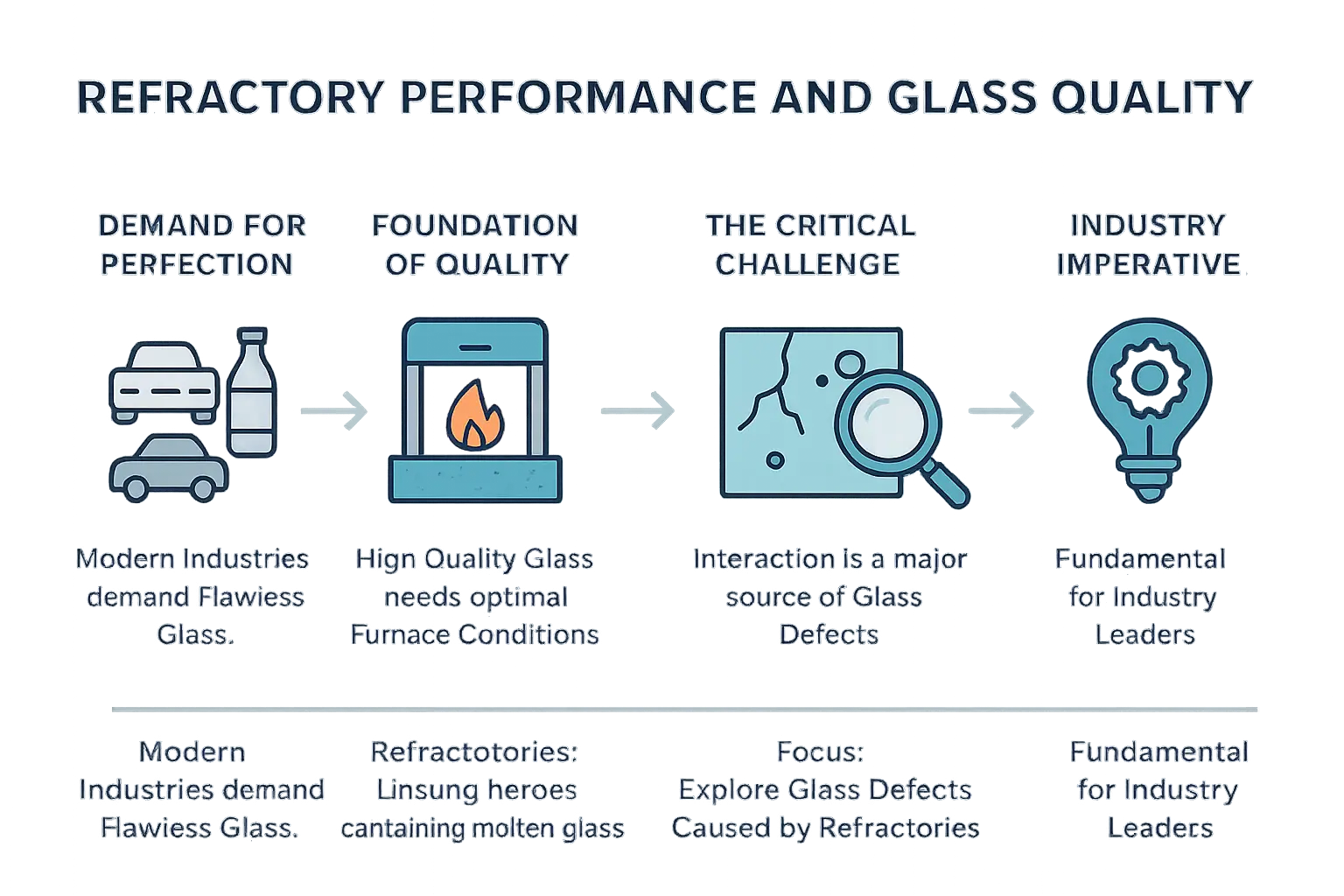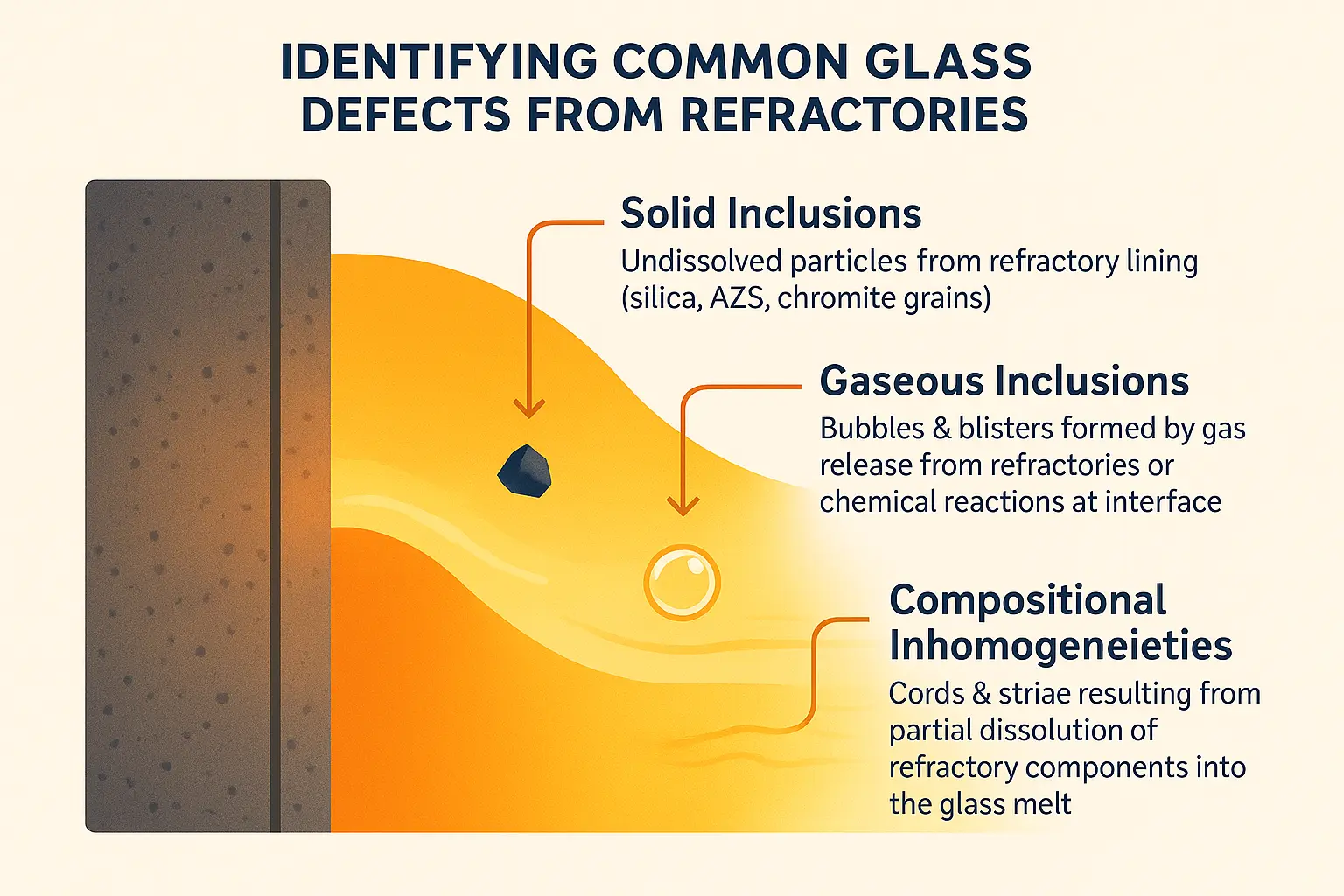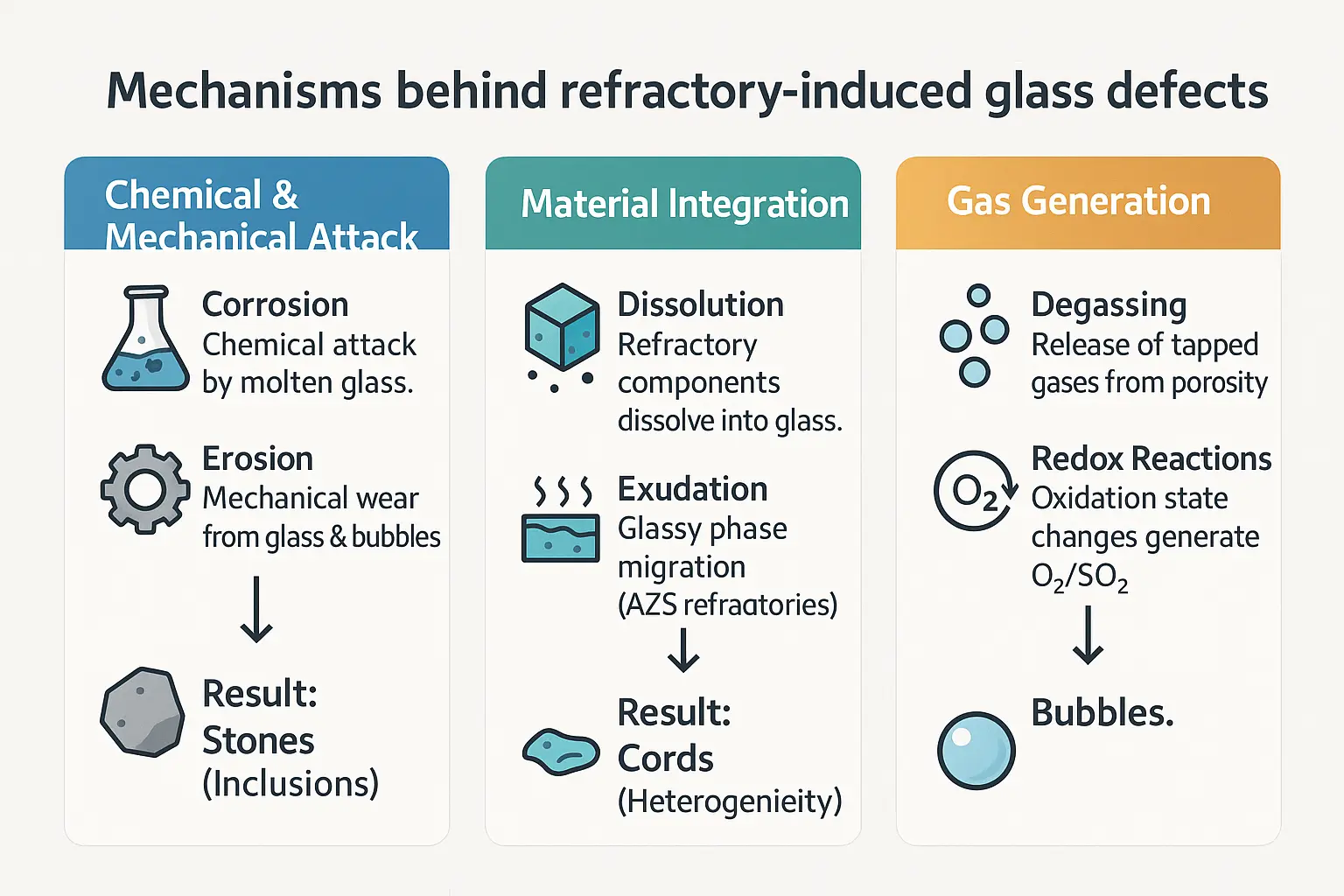Ever battled unexplained imperfections in your glass production? Glass defects caused by refractories silently undermine quality across industries—from automotive to architectural glass—leaving invisible bubbles, zirconia stones, or hazy cords in their wake. This article decodes how refractory wear, corrosion, and exudation trigger these flaws, exposing the hidden chemistry at play in your fusion furnace. Dive into the science behind solid inclusions from AZS refractories or silica drips, and gaseous defects tied to degassing. Discover how refractory materials directly shape glass quality, and unlock proven strategies—from material selection to furnace design—to turn defects into durability.
- The critical link between refractory performance and glass quality
- Identifying Common Glass Defects Originating from Refractories
- The mechanisms behind refractory-induced glass defects
- Source attribution: which refractories cause which defects?
- Strategies for prevention and quality control
- Partnering With Experts for Superior Glass Quality
The critical link between refractory performance and glass quality
Modern industries—from automotive to architecture—demand flawless glass. Yet this perfection relies on refractories lining fusion furnaces at 1,600°C. When these materials degrade, they introduce defects like inclusions (foreign particles) and bubbles (gas pockets), directly harming glass quality and profitability.
Refractories act as the furnace’s armor. Their erosion releases contaminants: silica crowns shed “fish-scale” inclusions, alumina-silica walls leach particles, and zirconia-silica linings dissolve into molten glass. Even nitrogen gas in new refractories spawns bubbles. These flaws cost manufacturers up to 10% of annual profits—millions wasted on rejects and rework.

For industries where a single inclusion in automotive glass weakens safety-critical components, or bubbles in architectural glazing ruin transparency, this isn’t just technical—it’s financial. MXS Refractories highlights that defects trace back to material selection, installation, and maintenance. Solutions? Precision sourcing, real-time monitoring, and advanced refractory engineering to prevent flaws and safeguard glass quality.
Identifying Common Glass Defects Originating from Refractories
Refractory materials in glass fusion furnaces are critical for high-temperature integrity. Their degradation directly introduces defects—ranging from inclusions to optical imperfections—that compromise strength, clarity, and aesthetics. These flaws cost industries millions annually, particularly in precision sectors like pharmaceutical packaging, where minor flaws render products unsellable. Even sectors like LCD manufacturing face rejection rates of up to 15% due to refractory-related defects, underscoring the economic stakes of refractory management.
Solid Inclusions: Stones and Knots
Solid inclusions are undissolved particles from refractory wear. Silica crowns (furnace ceilings) shed “fish-scale” particles identifiable under magnification. Alumina-silica walls contribute inclusions when eroded by thermal cycling. AZS (alumina-zirconia-silicate) refractories in high-contact zones release zirconia-silica grains as they degrade. Chromite refractories introduce dense specks when compromised. “Knots” form as glassy zones rich in alumina or zirconia from partial dissolution, acting as stress points that weaken the final product. These defects reduce mechanical strength by up to 30% in tempered glass, creating failure points under pressure.
Gaseous Inclusions: Bubbles and Blisters
Gaseous inclusions like bubbles (<1mm) and blisters (>1mm) stem from gas release. New AZS refractories emit nitrogen during initial degassing, while chemical reactions at the glass-refractory interface (e.g., redox processes) generate CO₂ or O₂. Blisters expand during refining, often due to unstable temperature gradients or insufficient residence time. In float glass production, even 0.1% gas content can trigger rejections, emphasizing the need for controlled refining atmospheres to minimize voids.
Non-Particulate Defects: Cords and Striae
Cords and striae arise from chemical homogeneity disruptions. Partial dissolution of refractory components like alumina or zirconia creates regions with altered optical properties. Alumina-silicate or zirconia-silicate drips from furnace walls—caused by overheating or alkali penetration—form layered inhomogeneities. These defects scatter light in optical glass, reducing transparency by up to 40% in fiber optics. In architectural glass, striae create wavy distortions visible under polarized light, degrading aesthetic value in high-end applications like skylights.
- Solid Inclusions: Silica (fish-scale morphology), AZS (zirconia-silica grains), or chromite (dark specks) weakening structural integrity through stress concentration.
- Gaseous Inclusions: Bubbles/blisters from AZS nitrogen degassing or redox reactions, especially under unstable furnace conditions like oxygen fluctuations.
- Compositional Inhomogeneities: Cords (alumina-rich zones) and striae (refractive distortions) from refractory spalling or zirconia dissolution in precision glass like labware or display panels.

Preventing these defects requires proactive strategies: selecting AZS with ≤2% porosity to reduce spalling, optimizing refining time to allow gas escape, and using alumina-zirconia spacers to minimize alkali penetration. Regular furnace inspections and thermal gradient monitoring further mitigate risks, ensuring compliance with strict industry standards like ASTM C162-22 for glass quality.
The mechanisms behind refractory-induced glass defects
Refractory degradation in glass furnaces directly causes defects through chemical, mechanical, and gas-related processes. Understanding these mechanisms enables manufacturers to implement targeted prevention strategies that maintain product quality. Over 40% of glass quality issues in continuous glassmaking operations originate from refractory interactions, making this a critical area for process optimization.
Corrosion and erosion
Corrosion begins when molten glass chemically attacks refractory surfaces at the glass line (1500°C+), dissolving components like zirconia or alumina into the melt. This creates inclusions – solid particles trapped in glass. Erosion accelerates material loss through mechanical wear from glass flow and rising bubbles, releasing refractory fragments that form “stones” – the most common refractory-related defect. In container glass production, these stones account for 60% of quality rejections.
AZS (Alumina-Zirconia-Silica) bricks corrode primarily through vitreous phase dissolution, leaving insoluble zirconia crystals as visible stones. These defects reduce mechanical strength by creating stress concentration points. These mechanisms are central to many common refractory failures and directly impact glass quality. The erosion-corrosion synergy particularly affects superstructure components like crown walls, where thermal cycling exacerbates material degradation.
Dissolution and exudation
Dissolution alters glass composition when refractory components dissolve into the melt, creating striae – wavy imperfections affecting light transmission. AZS materials face particular challenges as alkali vapors infiltrate brick pores, forming high-viscosity reaction layers that trap undissolved zirconia particles as cords. In float glass production, striae exceeding 0.1mm thickness can cause optical distortion in automotive applications.
Exudation forces the vitreous phase out of AZS bricks through alkali vapor infiltration, creating zirconia-rich crusts that flake into the melt. This generates bubbles (>0.5mm), stones, and cords. Masso’s 3SQC system limits vitreous phase content to under 19% in AZS 33 bricks while maintaining strict impurity controls (Fe2O3 + TiO2 below 0.5%) to mitigate these defects through material engineering.
Degassing and redox reactions
Porosity in refractory materials acts as a gas reservoir, releasing nitrogen during furnace startup and causing bubble defects. HZ (High Zirconia) materials with closed porosity below 5% volume significantly reduce gas content compared to open-pore AZS bricks. In fiber glass production, nitrogen outgassing contributes to 30% of initial bubble defects before equilibrium is reached.
Redox reactions in HZFC (High Zirconia Fused-Cast) refractories create blisters through oxygen semi-permeation, interfacial gas reactions, and bubble coalescence. Controlling iron’s oxidation state (Fe²⁺/Fe³⁺ ratio <0.1) and maintaining stable temperatures (1500-1600°C) reduces bubble formation. For coloration defects, precise Fe₂O₃ control (<0.05%) prevents unwanted green tints in soda-lime glass used for premium packaging applications.
Preventive measures include preheating refractories to 1200°C before glass contact to complete degassing and using zircon-dense materials in critical zones. These strategies directly address the root causes of refractory-induced defects while optimizing furnace efficiency through extended campaign durations.

Source attribution: which refractories cause which defects?
Fused-cast AZS refractories (Alumina-Zirconia-Silica) are a cornerstone of modern glass furnace construction, particularly in areas exposed to molten glass. Their primary failure mechanism involves exudation of vitreous phases that form cords – thin, thread-like imperfections. Over time, zirconia grains may also dislodge, creating zirconia “stones” that compromise optical clarity. These defects directly correlate with refractory lifespan and operational temperature stability. Advanced furnace designs now incorporate gradient refractory zones, reducing thermal gradients by 22% and extending defect-free production cycles.
AZS (Alumina-Zirconia-Silica) refractories
AZS refractories excel in corrosion resistance but require precise installation to minimize exudation risks. Their zirconia content creates distinct defect signatures: stones appear as 100-500µm crystalline inclusions while cords form layered striations visible under polarized light. Temperature fluctuations exceeding 1,600°C accelerate vitreous phase migration, increasing defect probability by up to 30%. Advanced monitoring systems now track exudation patterns in real-time, enabling proactive maintenance before defects appear in production batches. Manufacturers recommend periodic refractory profiling using laser interferometry to detect early-stage phase separation.
Silica and Alumina-Silica refractories
Silica refractories dominate furnace crowns, operating at 1,500-1,650°C where silica drips form through thermal softening. These molten droplets create fish-scale inclusions identifiable by hexagonal quartz remnants. Alumina-silica superstructures develop alumina-rich knots when spalling occurs, particularly near burner zones where thermal cycling creates microcracks. Both mechanisms increase defect counts by 15-25% under suboptimal combustion conditions. Modern crown designs incorporate zirconia additives to reduce silica volatilization, decreasing defect rates by 18% in recent trials. Regular burner alignment checks and oxygen enrichment strategies have further reduced silica drip defects by 12% through improved heat distribution.
Other influential materials
Chromite refractories demonstrate exceptional chemical stability but release black/green specks containing Cr2O3 when corrosion penetrates their protective spinel layer. Molybdenum electrodes, operating above 1,700°C, produce metallic spheres through Mo2C formation when carbon monoxide interacts with dissolved molybdenum ions. These defects show unique spectral signatures under UV-Vis analysis. Preventive measures include vacuum-melting electrodes to 99.98% purity and implementing controlled atmosphere chambers during electrode installation. Chromite degradation is particularly critical in container glass production where color consistency is paramount, requiring refractory replacement intervals to stay below 15% chromia leaching thresholds.
| Refractory Material | Common Defect Type(s) | Primary Mechanism |
|---|---|---|
| AZS | Zirconia stones, cords | Exudation, dissolution |
| Silica | Silica drips, stones | Corrosion, dripping |
| Alumina-Silica | Alumina-rich knots | Corrosion, spalling |
| Chromite | Black/green specks | Corrosion |
| Molybdenum Electrodes | Metallic spheres | Oxidation, erosion |
Strategies for prevention and quality control
Proper refractory selection and furnace design
The foundation of defect prevention lies in selecting refractories with properties tailored to specific furnace zones. Corrosion resistance, low porosity (1-2% for electrofused AZS bricks), and high thermal shock resistance are non-negotiable criteria. For example, zirconia-rich materials like AZS (Al2O3–ZrO2–SiO2) offer exceptional resistance to glass melt penetration due to their dense microstructure. Furnace geometry also matters: sloped walls and burner placement reduce hotspots in high-convection zones. A high thermal shock resistance is crucial for longevity, as highlighted in this analysis. Strategic material placement—such as using alumina-fused blocks in contact zones—minimizes contamination risks while maximizing structural integrity.
Optimized furnace operation and maintenance
Temperature control is a linchpin of refractory longevity. Exceeding recommended thresholds (e.g., above 1600°C for silica crowns) exponentially increases corrosion rates, with every 50°C increase potentially shortening refractory life by 15%. Operators must balance thermal efficiency with material limits, avoiding excessive heat that destabilizes phase structures in silica or zirconia-based linings. For instance, silica crowns above 1650°C risk cristobalite layer degradation, accelerating “fish-scale” inclusions.
Preventive maintenance protocols should include bi-annual inspections of high-stress areas like the glass line and electrode zones. Scheduled replacement of consumable refractories (e.g., AZS blocks) before 80% wear prevents catastrophic failure. Advanced monitoring systems, such as thermal imaging, detect early signs of degradation invisible to the naked eye.
Advanced diagnostic and analysis methods
When defects emerge, root-cause analysis becomes mission-critical. SEM-EDX (Scanning Electron Microscopy with Energy-Dispersive X-ray Spectroscopy) identifies inclusion chemistry with 98% accuracy, linking anomalies like “Gliding Frog” defects to aluminosilicate refractory reactions. Post-mortem analysis of furnace bricks reveals corrosion patterns, guiding material upgrades. For example, detecting neperlene in inclusions directly points to alumina-rich brick degradation, prompting a switch to zirconia-dense alternatives.
Preemptive testing includes laboratory corrosion simulations using glass melt exposure cycles. These tests compare refractory performance under operational conditions, identifying materials that resist penetration by molten glass or alkali vapors. Electrofused AZS outperforms sintered alternatives in high-wear zones due to its ultra-low porosity.
- Strategic Material Selection: Choosing refractories with optimal corrosion resistance and low defect potential for each furnace zone
- Intelligent Furnace Design: Engineering the furnace to minimize aggressive wear on the refractory lining
- Controlled Operating Conditions: Maintaining stable and optimized temperatures and glass flow to reduce refractory stress
- Proactive Maintenance and Monitoring: Implementing a schedule for inspection and replacement to prevent catastrophic failures
Partnering With Experts for Superior Glass Quality
Eliminating glass defects caused by refractory degradation requires a holistic approach combining advanced materials, furnace design, and operational expertise. Inclusions or nitrogen bubbles threaten quality, yield, and profitability. Poor refractory choices introduce contaminants like alumina-silica particles, hurting glass clarity and strength.
High-performance refractory solutions like corrosion-resistant AZS bricks and low-porosity fused silica form the first defense. However, materials alone aren’t enough. Design flaws or inconsistent thermal management still cause striae, bubbles, or color inconsistencies. Partnering with MXS Refractories ensures every component—from crown walls to molten glass zones—meets rigorous purity and durability standards. With decades of experience, we deliver precision-engineered solutions.
MXS tailors high-performance refractory solutions to your furnace’s needs, minimizing defects while boosting uptime and energy efficiency. Our engineers identify degradation patterns, optimize material placement, and supervise installations to prevent contamination. For example, calcined silica bricks reduce initial bubble formation by 70% versus raw refractories, and CNC-machined components ensure precision installation.
Ready to eliminate defects? Contact our team of experts to enhance glass production quality. Let MXS Refractories transform your furnace performance, ensuring every batch meets your highest standards.
The link between refractory performance and glass quality highlights the critical need to address glass defects caused by refractories. A holistic approach—strategic materials, optimized furnace design, and proactive maintenance—can reduce stones, bubbles, and flaws. Partnering with experts like MXS ensures tailored high-performance refractory solutions. Contact our team of experts today to enhance your glass quality.
